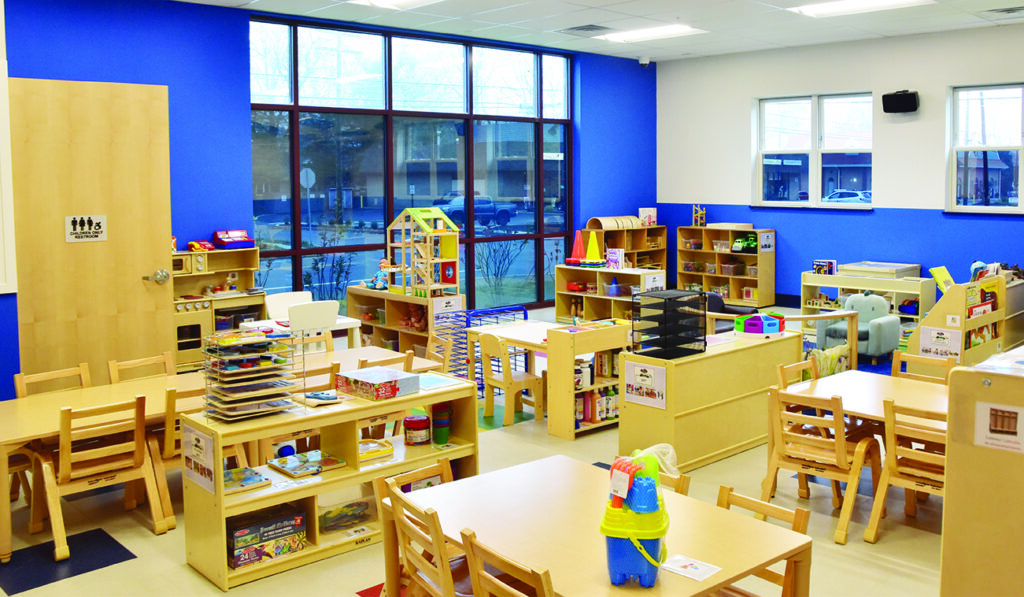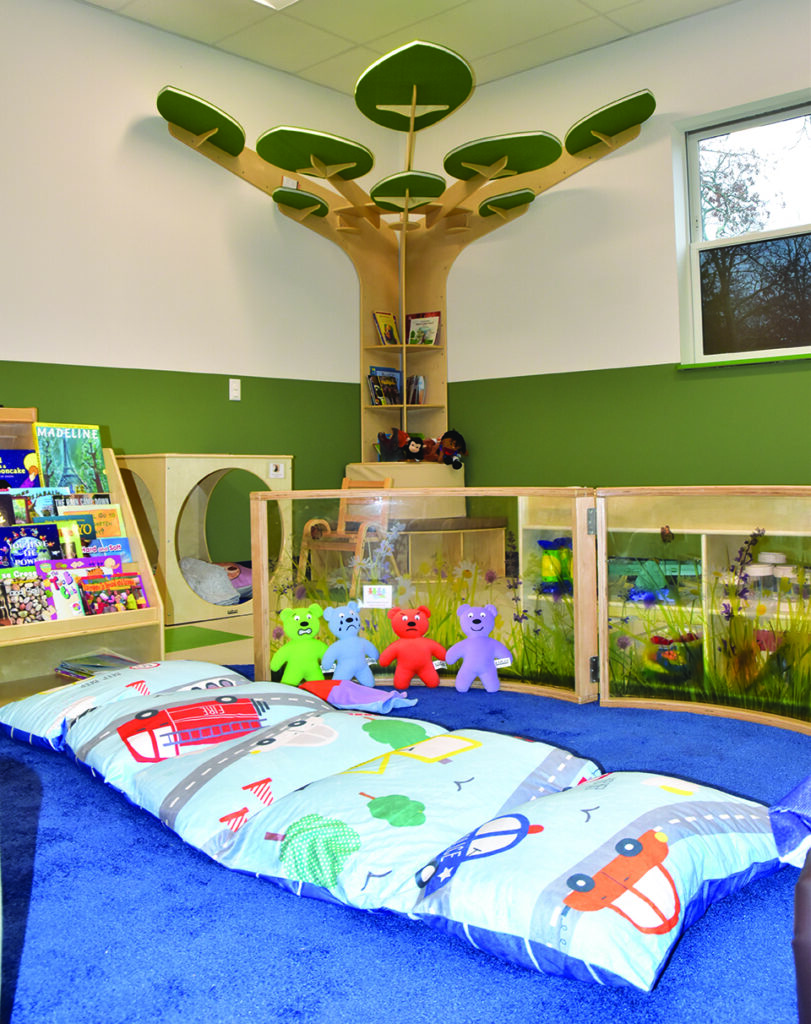NORTHFIELD — “Our job is not to tell them how the world works but to help them discover how the world works,” owner Liz Palmer said of students in her early childhood education centers. “They’re learning all of the concepts through the guidance of our teachers.”
Children Academy Childcare & Learning Center in Northfield is set to open to students Jan. 9 after about 18 months of construction.

The project included demolition of the Northfield Plaza at the corner of Route 9 and Ridgewood Avenue — which was home to a travel agency, hair salon and other businesses — and construction of a state-of-the-art facility that incorporates child care, education, safety, security and well-being into its mission.
Palmer started working in early childhood education in 2000 with Tutor Time in Brick Township. She and her husband, Olufemi, opened their first Children Academy in 2006 in Galloway Township and are now working toward a third site at Palmer Plaza, under development in Egg Harbor Township. She said that would include the school and a 10,000-square-foot retail and office complex with a restaurant pad.
The Northfield learning center has 10 classrooms and four outdoor play areas divided into four age ranges — 6 to 18 months, 18 months to 2.5 years, 2.5 to 3.5 years and 3.5 to 5 years. The school caters to children ages 5 through 12 years only through its summer explorer camp.
“We are offering peace of mind,” Palmer said. “A happy, quality place for children to grow and learn.”
Palmer stressed the educational component, saying it’s instituted even with the infants.
“We are not baby sitters; this is a school,” she said. “We provide things based on research, the curriculum and assessment program are research-based.”
Palmer, a trained physical education and health teacher who has a bachelor’s degree in psychology and a master’s degree from Kean University, has been in the child care business since 1999.
She said people now see the value of early childhood education, calling those years the most crucial time in development.
“What happens in this age group sets the tone for what happens for the rest of their lives and their approach to learning is built at this age,” she said. “It’s not so much about the content of what we teach, we are teaching them strategies to problem-solve.”
Operating principles
Manager Rachel Psota, 40, of Egg Harbor Township, was hired to manage the facility. She said she has 20 years of experience as a preschool and middle school teacher with certificates of eligibility for high school biology and middle school science.
The Jacksonville, Fla., native said she is looking forward to “continuing to build relationships with my families,” noting she stays in contact with some of her former sixth-graders who are now college students.
Psota said the school currently has six teachers and could accommodate 155 students. She, too, noted that the facility provides much more than day care.
Psota said they use the Brigance screening method to determine where students are developmentally and the Creative Curriculum for instruction.
“Even newborns are learning,” she said. “With the infants, we are always helping them reach their next milestone.”
She said teachers must submit lessons plans weekly to be approved.
In addition to the teachers, the school has a family resource coordinator, on-site cook and full-time cleaner.
Students are served breakfast, lunch and a snack each day. Palmer said the cook prepares all meals on-site and that they include starch, vegetable and protein options.
Students can bring their own food and Palmer said they can accommodate some dietary needs. Nuts and shellfish are prohibited.
Palmer said all teachers at the facility are trained in child development, including emotional, physical and social health.
“Math and literacy are built into all of the activities and embedded in their daily routines,” Palmer added.
Familiar setting
The lobby is designed to resemble a downtown, Palmer said, with building facades lining the walls. She said the curriculum is designed to relate to what children see in their daily lives.
“We designed a downtown area that gives teachers tools to talk about things in a relatable manner to children,” Palmer said. “We’ve chosen things to stimulate but not overstimulate. The choice of colors in our décor is also important. We have toned-down colors so that children can focus.”
The school also incorporates natural products into its lessons, such as rocks, leaves, pine cones and shells.
“Today’s children have a disconnection with nature,” Palmer said, noting it’s important to revive that connection.
Furthering the nature theme, the rooms for older students have a learning tree with books for children to read.
“We intentionally pick books that portray both sexes in different careers. We want to get away from the stereotype where you have to be a man to be a doctor,” Palmer said. “This normalizes it at a younger age.”
The infant rooms have cribs and separate food-preparation and diaper-changing area.
“We’ve created spaces for babies to move around in a safe environment,” Palmer said.
Each room has a bathroom and at least two sinks to cut down on the distance dirty hands must travel though the classroom. In the bathroom, everything in touch-free including the lights.
The infant rooms also have a UV sanitation system for binkies, tooth brushes, cups and other items that may go into the mouth.
The toddler rooms include tables with chairs but also softer areas for relaxing.
“We provide soft surfaces for children so they feel more at home,” Palmer said. “Cozy areas where kids can get alone time.”
They also offer ways to introduce students to unique spaces and let them explore. Palmer said they chose toys that help boost fine motor skills, preparing the student for future writing skills.
There also are areas for active exploration.
The prepper preschool program is for those not quite ready for preschool but too old for the toddler program.
“Age grouping is really important because you have a bunch of kids at the same developmental level,” Palmer said. “The needs of a 2-year-old are very different than the needs of an infant. Our spaces target the specific age group to meet their needs at that age level.”
This is where students begin to work in small groups in preparation for the preschool group and ultimately kindergarten by learning to share, use language and proper diction.
The preschool rooms include small and large group areas including a library, science center, movement and music spot and others.
“Their journey goes from here into kindergarten,” Palmer said.

No screen time
“Do you notice anything missing from the classrooms?” Palmer asked a reporter. “We don’t have televisions in our classrooms. They get enough of that at home and they’re here to learn.”
Palmer said students get almost no screen time.
“This is a place for them to interact,” she said. “Children are losing the opportunity to connect to people face to face.”
Likewise, teachers may not have their phones while working.
“Distraction is a major problem,” Palmer said. “Children have to be constantly supervised.”
The screen-free environment is intended to boost active learning.
“Children will be here and teachers will engage them. They will have fun. They will have opportunities to be indoors, outdoors and run around and be kids like it used to be, but also teachers are walking around intentionally engaging with them with learning opportunities,” Palmer said.
By CRAIG D. SCHENCK/Sentinel staff


